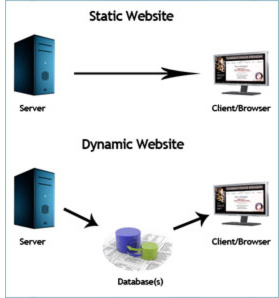
Roughly speaking, there are two kinds of Web sites: those with static content and those with dynamically generated content. These are also called static Web sites and dynamic Web sites, or Web sites with static pages versus Web sites with dynamic pages.
What is Web content? Content is everything that can appear on a Web page: text, graphics, form fields, hyperlinks to other pages, navigation buttons, menus, etc. Please note that static and dynamic content has nothing to do with page animation.
Standard or Static Web site:
A static web site is a web site that was developed using a basic web development programming code such as HTML. Like any printed advertisement or magazine article, once it has been printed it can no longer be changed. Changes can only be made at the next print run. Similarly, once a static web site has been published it too will not change until the next edition; whenever we receive a request to edit the content from our client. Static web sites can only really be updated by someone with knowledge of web site development. Static web sites are the cheapest to develop and host, and many smaller companies still use these to get a web presence.
Advantages of static web sites:
- Quick to develop
- Cheap to develop
- Cheap to host
Disadvantages of static web sites
- Requires web development expertise to update site
- Site not as useful for the user
- Content can get stagnant
- Can't be optimized for search engines (since you can't update it easily)
- Usually can't be more than 10 pages
Static web pages are created one by one and each page is physically present on the web server. Each page contains the source code the web server will send to your visitors to view in their web browser. If you are the webmaster yourself and the only one adding and maintaining content this solution should work just fine. It is also the preferred solution for small web sites but can be used also for bigger sites.
Dynamic or Database-driven Web site Development:
Dynamic sites on the other hand can be more expensive to develop initially, but the advantages are numerous. At a basic level, a dynamic web site can give the web site owner the ability to simply update and add new content to the site. For example, news and events could be posted to the site through a simple browser interface. Dynamic features of a site are only limited by imagination. Some examples of dynamic web site features could be:
- content management system,
- Job boards
- Blogs
- Client relationship management
- Help desks
- E-commerce system,
- Forum / discussion boards
- Intranet or extranet facilities.
A dynamic web site uses programming in addition to the layout to not only allow the flow of data in and out of the site but to make meaningful relationships with the data. Dynamic web sites empower their owners with the ability to upload / update information on their own, preferably through password protected administrative interfaces. One does not require knowledge about HTML or web sites design to update or maintain such a site.
Advantages of dynamic web sites
- Much more functional web site for the client
- Much easier to update, edit or delete content
- New content brings people back to the site and helps in the search engines
- Can work as a system to allow staff or users to collaborate
Disadvantages of dynamic web sites
- Takes more time to develop
- more expensive to develop
- Hosting costs a little more expensive
While a dynamic web site typically cost more because of its complexity, it can be a more cost effective solution in the long run. A dynamic web site is the most effective solution for sites with content requiring frequent updates and/or interaction with the visitors.
Does my company web site need to be static or a dynamic?
Dynamic websites empower their owners with the ability to upload information on their own, preferably through a password protected CMS (Content Management Systems) GUI (graphic user interface). The real beauty and power of a dynamic web site is the client does not require any programming knowledge to update or maintain their company website.
In addition to the budget there are several other factors that will determine if you need a static or dynamic site. What purpose will your site serve? If you are a relatively small business or the products and services that you provide need few updates or amendments, then a static website could suffice your needs. On the other hand if you have a large inventory of products and/or services or you frequently need your company website to be updated with new product information, news or special offers then you will require a dynamic database-driven website.
In addition, a web application that is driven by a database, whether it be a web site, intranet, extranet or online shop can empower your customers with the ability to search your website and store visitor and customer details.
Many sites from the last decade are static, but more and more people are realizing the advantages of having a dynamic website. Dynamic websites can make the most of your site and either use it as a tool or create a professional, interesting experience for your visitors.
